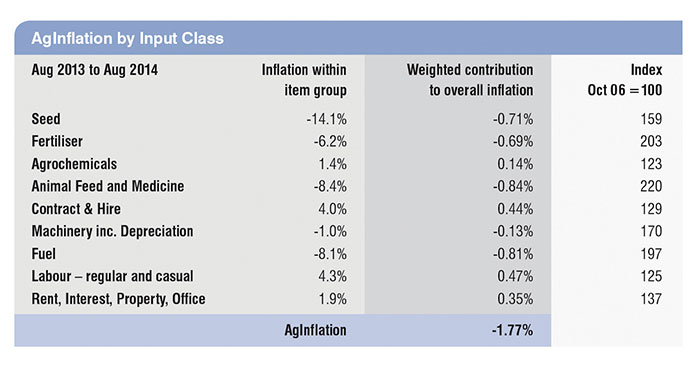
The average cost of inputs into agriculture has fallen, the latest AF AgInflation Index figures have shown.
The figures for August 2013 - August 2014 show an overall reduction in input costs of -1.77%. This is the first time input costs have fallen since 2008/9.
AF chief executive Clarke Willis said: “This reflects the reduction in fertiliser, seed, animal feed and fuel cost over the past year.
“The fall in the cost of fuel in particular reflects the continual reduction in fuel prices, with the price of a barrel now well below $100 and predicted to fall further in the coming months.”
Strong increases have been experienced in hire and labour costs (up 4.3%), with the average wage for a labour craftsman up by 5% - probably linked to the abolition of the Agricultural Wages Board. A 4.0% increase in contract and hire costs has been driven by prices for tractor hire, which peaked last winter.
The cost of some inputs has fallen significantly, with fuel prices down by -8.1% compared to an increase of 8.5% in the previous 12 month period.
Seed prices have also experienced a substantial drop – during 2012/13, seed prices increased by 3.8% but in the past 12 months have fallen by -14.1%.
Fertiliser prices continue to fall, down -6.2%. Chemical costs have risen slightly by 1.4% - most likely due to high demand during the season and the cost of chemical production going up.
The Retail Price Index has fallen by -0.5% in the same period, the first time since before the AF AgInflation Index was first calculated in 2006 that the cost of buying food has fallen.
Mr Willis added: “Although the gap has narrowed very slightly, there is still a significant differential between the cost of inputs and the RPI. Both were given an index figure of 100 when AF AgInflation figures were first calculated in October 2006 and the figures now stand at 169 (AgInflation) and 140 (RPI).
“Figures by farm enterprise have largely followed the market trends, with beef and lamb production costs changing only by -0.31%. While retail sale prices have increased very slightly (0.3%), livestock producers continue to be under significant pressure.”
Figures by enterprise show that production costs have gone down for all cropping – potatoes by -1.55%, combinable crops by -1.52%, dairy by -1.47% and sugar beet by -0.87%.
The prices paid by consumers have dropped for many products – bread and margarine prices have fallen by -4.4%, potatoes by -14.7% and granulated sugar by -3.3%.
Costs in the index are noted when they are experienced rather than when the inputs are used and the prices reflect prudent purchasing practice so may include, for example, fertiliser purchased but not applied until the following year.
Launched in 2006 by Anglia Farmers, the index has become a definitive tool for assessing the cost of farming production and guiding negotiations within the wider food industry.
Using information from the group’s buying office, the index is intended to reflect the changing expenditure of farming and is a weighted average of nine cost centres and 132 cost items. Weightings within cost centres and between them are based on average farm and grower expenditure.
